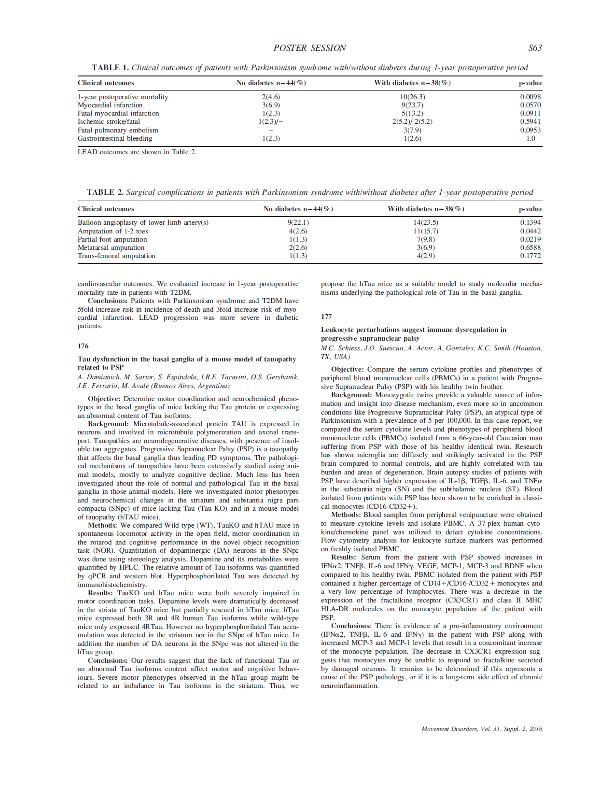Mostrar el registro sencillo del ítem
dc.contributor.author
Damianich, Ana

dc.contributor.author
Sartor, Manuela

dc.contributor.author
Espindola, Sonia Lorena

dc.contributor.author
Taravini, Irene Rita Eloisa

dc.contributor.author
Gershanik, Oscar Samuel

dc.contributor.author
Ferrario, Juan Esteban

dc.contributor.author
Avale, Maria Elena

dc.date.available
2021-07-06T13:39:53Z
dc.date.issued
2016
dc.identifier.citation
Tau dysfunction in the basal ganglia of a mouse model of tauopathy related to PSP; 20th International Congress on Parkinson's Disease; Berlín; Alemania; 2016; 1-1
dc.identifier.issn
1531-8257
dc.identifier.uri
http://hdl.handle.net/11336/135550
dc.description.abstract
Objective: Determine motor coordination and neurochemical phenotypes in the basal ganglia of mice lacking the Tau protein or expressing an abnormal content of Tau isoforms.Background: Microtubule-associated protein TAU is expressed in neurons and involved in microtubule polymerization and axonal transport. Tauopathies are neurodegenerative diseases, with presence of insoluble tau aggregates. Progressive Supranuclear Palsy (PSP) is a tauopathy that affects the basal ganglia thus leading PD symptoms. The pathological mechanisms of tauopathies have been extensively studied using animal models, mostly to analyze cognitive decline. Much less has been investigated about the role of normal and pathological Tau in the basal ganglia in those animal models. Here we investigated motor phenotypes and neurochemical changes in the striatum and substantia nigra pars compacta (SNpc) of mice lacking Tau (Tau KO) and in a mouse model of tauopathy (hTAU mice).Methods: We compared Wild type (WT), TauKO and hTAU mice in spontaneous locomotor activity in the open Öeld, motor coordination in the rotarod and cognitive performance in the novel object recognition task(NOR). Quantitation of dopaminergic (DA) neurons in the SNpc was done using stereology analysis.Dopamine and its metabolites were quantiÖed by HPLC. The relative amount of Tau isoforms was quantiÖed by qPCR and western blot. Hyperphosphorilated Tau was detected by immunohistochemistry.Results: TauKO and hTau mice were both severely impaired in motor coordination tasks. Dopamine levels were dramatically decreased in the striata of TauKO mice but partially rescued in hTau mice. hTau miceexpressed both 3R and 4R human Tau isoforms while wild-type mice only expressed 4RTau. However no hyperphosphorilated Tau accumulation was detected in the striatum nor in the SNpc of hTau mice. In additionthe number of DA neurons in the SNpc was not altered in the hTau group.Conclusions: Our results suggest that the lack of functional Tau or an abnormal Tau isoforms content affectmotor and cognitive behaviours. Severe motor phenotypes observed in the hTau group might be related to animbalance in Tau isoforms in the striatum.Thus, we propose the hTau mice as a suitable model to study molecular mechanisms underlying the pathological role of Tau in the basal ganglia.
dc.format
application/pdf
dc.language.iso
eng
dc.publisher
International Parkinson and Movement Disorder Society
dc.relation
https://www.mdsabstracts.org/sessions/parkinsonism-msa-psp-secondary-and-parkinsonism-plus-2016
dc.rights
info:eu-repo/semantics/openAccess
dc.rights.uri
https://creativecommons.org/licenses/by-nc-sa/2.5/ar/
dc.subject
TAU
dc.subject
MOTOR COORDINATION
dc.subject
FRONTOTEMPORAL DEMENTIA
dc.subject
COVID-19
dc.subject.classification
Neurociencias

dc.subject.classification
Medicina Básica

dc.subject.classification
CIENCIAS MÉDICAS Y DE LA SALUD

dc.title
Tau dysfunction in the basal ganglia of a mouse model of tauopathy related to PSP
dc.type
info:eu-repo/semantics/publishedVersion
dc.type
info:eu-repo/semantics/conferenceObject
dc.type
info:ar-repo/semantics/documento de conferencia
dc.date.updated
2021-07-05T16:40:14Z
dc.journal.volume
31
dc.journal.number
Supl. 2
dc.journal.pagination
1-1
dc.journal.pais
Estados Unidos

dc.journal.ciudad
Wisconsin
dc.description.fil
Fil: Damianich, Ana. Consejo Nacional de Investigaciones Científicas y Técnicas. Instituto de Investigaciones en Ingeniería Genética y Biología Molecular "Dr. Héctor N. Torres"; Argentina
dc.description.fil
Fil: Sartor, Manuela. Consejo Nacional de Investigaciones Científicas y Técnicas. Instituto de Investigaciones en Ingeniería Genética y Biología Molecular "Dr. Héctor N. Torres"; Argentina
dc.description.fil
Fil: Espindola, Sonia Lorena. Consejo Nacional de Investigaciones Científicas y Técnicas. Instituto de Investigaciones en Ingeniería Genética y Biología Molecular "Dr. Héctor N. Torres"; Argentina
dc.description.fil
Fil: Taravini, Irene Rita Eloisa. Consejo Nacional de Investigaciones Científicas y Técnicas; Argentina
dc.description.fil
Fil: Gershanik, Oscar Samuel. No especifíca;
dc.description.fil
Fil: Ferrario, Juan Esteban. Consejo Nacional de Investigaciones Científicas y Técnicas; Argentina
dc.description.fil
Fil: Avale, Maria Elena. Consejo Nacional de Investigaciones Científicas y Técnicas. Instituto de Investigaciones en Ingeniería Genética y Biología Molecular "Dr. Héctor N. Torres"; Argentina
dc.relation.alternativeid
info:eu-repo/semantics/altIdentifier/url/https://movementdisorders.onlinelibrary.wiley.com/doi/10.1002/mds.26688
dc.conicet.rol
Autor

dc.conicet.rol
Autor

dc.conicet.rol
Autor

dc.conicet.rol
Autor

dc.conicet.rol
Autor

dc.conicet.rol
Autor

dc.conicet.rol
Autor

dc.coverage
Internacional
dc.type.subtype
Congreso
dc.description.nombreEvento
20th International Congress on Parkinson's Disease
dc.date.evento
2016-06-19
dc.description.ciudadEvento
Berlín
dc.description.paisEvento
Alemania

dc.type.publicacion
Journal
dc.description.institucionOrganizadora
International Parkinson and Movement Disorder Society
dc.source.revista
Movement Disorders Society
dc.date.eventoHasta
2016-06-23
dc.type
Congreso
Archivos asociados
